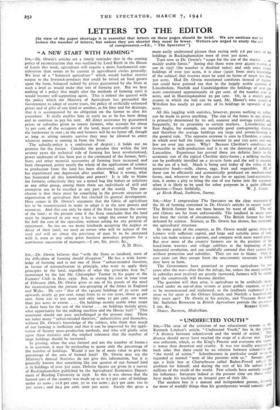SIR,—Dr. Orwin believes that "with the State as landlord, most
of the difficulties of farming should disappear." He has a wide know- ledge of farming and is not one of those "urban-minded theorists, in favour of nationalisation in principle, who want to apply their principles to the land, regardless of what the principles may be," mentioned by the late Mr. Christopher Tumor in his paper at the Farmers' Club in May, 1939. But, in stating his case in your issue of February 28th, Dr. Orwin gives as one of his proofs of the need for reconstruction the present size-grouping of the farms in England and Wales. He says 'that of the 140,000 holdings of so acres and upwards, nearly 45 per cent, range from so to too acres, about 45 per cent. from too to 300 acres and only some TO per cent. are more than 300 acres in extent. . . . On holdings mainly arable what scope is there here for the use of the tractor . . . on holdings mainly grass, what opportunity for the milking machine and the Hosier bail?" This statement should not pass unchallenged at the present time. There are today many "urban-minded theorists," industrialists and financiers, without Dr. Orwin's knowledge of the subject, who think that much of our farming is inefficient and that it can be improved by the appli- cation of factory mass-production methods, and who will gladly seize upon these statistics and the implied inference that the number of large holdings should be increased.
In passing, when the area farmed and not the number of farmeis is in question, it may be misleading to quote only the percentage of the number of holdings. Would it not be of more value to give the percentage of the area of fanned land? Dr. Orwin may say the Ministry's Annual Statistics do not give this information, but it is generally known that something like one quarter of our farmed land is in holdings of over 300 acres. Definite figures are given in a survey of Buckinghamshire published by the Agricultural Economics Depart- ment of Reading University in 1938. In this it was shown that the fanned area of the country was made up as to 9.5 per cent, of holdings under 50 acres ; 11.8 per cent. 5o to too acres ; 49.3 per cent. too to 300 acres ; and 29.4 per cent. over 300 acres. Surely this gives a
more easily understood picture than saying only 5.6 per cent, of the holdings in Buckinghamshire were of over 300 acres.
Turn now to Dr. Orwin's "scope for the use of the tractor, on mainly arable farms." Seeing that there were over 40,000 tractors in use in 1937 (the number is doubled today) and only some ij,Oot holdings of over 300 acres, it is clear (apart from one's lenowledge of the subject) that tractors must be used on farms of much less than 300 acres. Had Dr. Orwin mentioned combines instead of tractors one could have pointed out that in the largely arable counties of Lincolnshire, Norfolk and Cambridgeshire the holdings of over 300 acres constituted approximately 16 per cent, of the number over 50 acres, and in Huntingdonshire 20 per cent. Or, in a mainly grass county in which the bail can be used, Mr. Hosier's own county of Wiltshire has nearly 20 per cent, of its holdings in upwards of 300 acres.
All this juggling with statistics, however, proves nothing or, rather, can be made to prove anything. The size of the farms in any district is primarily determined by its soil, contour and average rainfall and, frequently, by its proximity to certain markets. Lincolnshire and East Anglia, for example, are naturally good corn-growing districts and therefore the average holdings are large and power-farming is the general rule. The opposite extreme is seen in Cheshire, a county in which over half the farms are between 5o and too acres and very few are over 300 acres. Why? Because Cheshire's conditioLs are favourable to milk-production and it is on the doorstep of industrial Lancashire. Experience has proved there are definite limits to the economic size of the typical Cheshire dairy-farms ; a milking machine can be profitably installed on a 50-acre farm and the soil is unsuited to the use of a bail. Much is being said today of the value of the protective foods—milk, cheese, eggs, fruit and vegetables. All of these can be efficiently and economically produced on medium-sized farms, and, whatever may be the case for or against land-nationalisa- tion, it seems a pity to bring the size of our farms into the argument when it is likely to be used for other purposes in a quite different
direction.—Yours faithfully, W. J. CASEY. 41 Hook Road, Surbiton, Surrey.






























 Previous page
Previous page